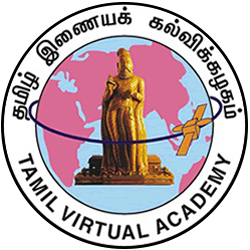Primary tabs
-
D01126 Lesson 6 Akananuru- 3
This lesson offers an insight into the wealth of sociological and historical details found in ‘Akananuru’. It throws light on marriage rituals, religious beliefs, social codes, individual morality, occupation and pastime of the people who lived during the sangam age. Great literature mirrors life. This is also true of ‘Akananuru’. The poems in this anthology reflect the culture and customs of the people of its time.The poems in ‘Akananuru’ cover the entire gamut of family life, beginning from love and marriage. The ‘Akananuru’ speaks of 3 types of marriages: 1) the thalaivan and the thalaivi meeting each other and getting married, 2) the thalaivan and the thalaivi marrying each other with the consent of their parents, and 3) marriage formally arranged by the parents. There were several rituals associated with marriage. We learn that in those days it was the parents’ special duty to safeguard their girls once they came of age. It was customary to renew one’s house before the marriage of one’s children. The girl who was engaged to be married was made to go through the ritual of her mother removing her anklets. This was known as ‘Silambukazhi’. The day of the marriage was preceded by the custom of ‘parisam poduthal’ when the families of the bride and the bridegroom agreed on the bride price. The actual ceremony of marriage comprised of several rituals. Poet Nallaavur Kizhaar has compiled these rituals. It was believed that a marriage attained fulfillment with the birth of children. Women who bore children were treated with great reverence and the children were considered the ‘kulavilakku’ or the light of the family. The family man was bound by duties both to his family and the society. Paying respects to one’s ancestors by observing certain annual rites and rituals was considered to be the sacred duty of the patriarch of the family. Similarly, it was important to help the poor and the needy. The ‘Akananuru’ abounds in references to personal morality and the behaviour expected of the elderly and the learned.
The poems also allude to the religious beliefs of the people. We learn of temples built of brick walls. There was also the custom of deifying individuals who served the Kingdom. The cult of worshipping individuals who gave their lives for their country was called ‘nadukal vazhipaadu’. Each landscape had a presiding deity. Murugan was the presiding deity of Kurunji tinai while Thirumaal was associated with the Mullai tinai.
The poems in ‘Akananuru’ provide valuable information on the types of occupation of the people of that age. Agriculture was the primary occupation. Some engaged in trade within the kingdom. It is interesting to note that the people of Tamilnadu had established trading relations with people of other countries even as early as the Sangam age.
The poems in ‘Akananuru’ also throw light on the favourite pastimes of the people of the Sangam age.


